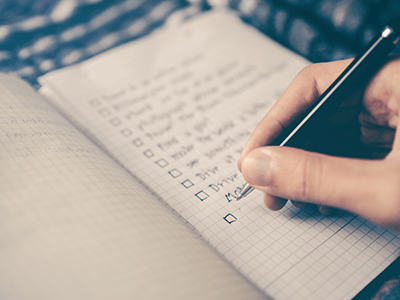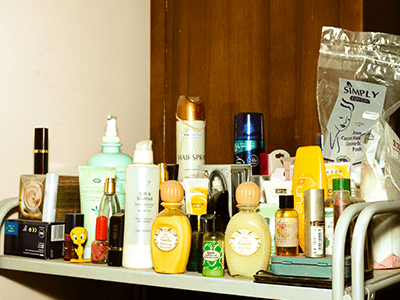
We’ve also created a free printable decluttering checklist PDF, so you can see your progress as you tidy!
Download our “declutter your home” checklist PDF
How to use our “declutter your home” checklist
The list below includes categories of things you may have within your house. You don’t need to get rid of everything, but for each item on the list, it’s worth considering whether you could live without it. There will be plenty of items that you can easily get rid of, but it’s also important to take the time to really interrogate your instinct to keep items that you don’t regularly use. Do you really need a backup oven mitt? Is it worth holding onto that restaurant menu when you can easily get it online? If a cable doesn’t go to something, and you don’t know what it does go to, does it really need space in your drawer?
Are you decluttering your home before you move house? Take a look at our self storage tips for moving house!
Sell, donate or put in the rubbish?
If you’re taking our “declutter your home” checklist seriously, you’ll probably end up with a decent amount of stuff you intend to get rid of. Before tossing it all in the bin, consider first whether it may still have use for someone else.
Charity shops are happy to take working electronics, clothes that are in good shape, and plenty of other household items. If you’re getting rid of something because you no longer want it (rather than because it no longer works), consider making a trip to your local charity shop – you’ll still be getting rid of it, and you’ll have done some good!
If something is broken or may not have use for someone else, be sure to dispose of it responsibly. Most paper goods can be easily recycled with your household recycling, while electronics and batteries are a little more complicated. Check out your council’s recycling website or your local waste disposal site to find out what you can safely get rid of in your area.
Is your county the best or worst at recycling? Take a look at our updated recycling statistics that reveal the best and worst recyclers in Britain.
Kitchen
Some of the most common clutter to accumulate in the kitchen is unused cutlery, crockery, and cooking equipment. Asking “what’s one more mug” can quickly land you with a collection of dozens of unused mugs! Be sure to check every drawer and be honest with yourself about whether you ever really use those whiz-bang kitchen gadgets.
Another of our top decluttering tips is to go through all the canned goods and spices to find out when they expire – there’s no use taking up shelf space for expired items.
Here are some more items to look out for in the kitchen:
Bathroom
There is always a row of items in the medicine cabinet that manages to go unnoticed, but now is your chance to clear it out. In the bathroom, the most common clutter takes the form of expired products, nearly empty bottles, or ratty old towels. Take this opportunity to get some nice new ones as a reward for decluttering!
Things to look for in the bathroom:

Bedroom
Clothing constitutes the primary source of clutter in the bedroom. If in doubt, try one of the timeless decluttering tips: turn hangers one way at the start of the season and turn them the other way round once you’ve actually worn that item. At the end of the season, you can take a look at the never worn clothes, those on backwards hangers, and get rid of them safe in the knowledge that they weren’t in use.
As a rule, you only need two sets of bedclothes for each bed in the house. If you have more, consider getting rid of the least nice set. There are no rules for blankets and pillows, but if you suspect you may have too many, that’s a sign that it’s worth getting rid of some!
Other things to look for in the bedroom:
Storing unused furniture is a great way to make some space! See how we can help with your furniture storing needs.
Children’s rooms
With children’s things, it’s a fine line between “cherished memory” and “old junk.” It’s natural to include nostalgia in your decision-making process but try not to let it play too outsized a role. After all, how often are you revisiting old sets of clothes for the memories?
One of the common nostalgia-countering decluttering tips is to create a box for memories. If something doesn’t fit in the box, it has to go. If you want to keep it, you need to make room by removing other things – sometimes it will be clearer what to keep and what to get rid of as time passes.
Here are some items that are known to create clutter in a child’s bedroom:
Office or workspace
As a general rule, if you don’t use something in your workspace on a daily or weekly basis, it can either be disposed of or moved elsewhere.
Look out for the following items in your home office:

For more office decluttering tips, check out our complete working from home guide.
Living room
The living room is, surprisingly, often fairly clutter free. Given that you may only watch a given movie or play a certain boardgame every now and again, it’s more like a library for your entertainment. That said, even the best library needs a tidy now and again, especially if you’re never likely to watch, read, or play something again.
Here are some items that might be creating clutter in your living room:
Have you found lots of DVDs during your de-clutter session? Take a look at our top tips on how to get rid of old DVDs!
Paper products
Because they’re so common and unassuming, paper goods are a particular clutter risk. We often tell ourselves that we’ll “read that later,” but we’re often fooling ourselves. If you haven’t read it yet, either get to it or take it to the recycling.
Be prepared to de-clutter the following paper products:
Storage
Every house seems to have a “junk drawer” filled with old restaurant menus, loose screws and batteries, and mysterious cables for electronics. This drawer is a prime target for decluttering! Consider how often you really go looking for something in it – if the answer is rarely or never, go ahead and toss the lot.
Get ready to dispose of:
Consider storage
If you’ve removed all the clutter from your home but still want more room, consider self storage. At Access Self Storage, we have over 60 secure, modern self storage facilities all over the country – and our prices can’t be beaten.
To find your nearest facility, use our store search.